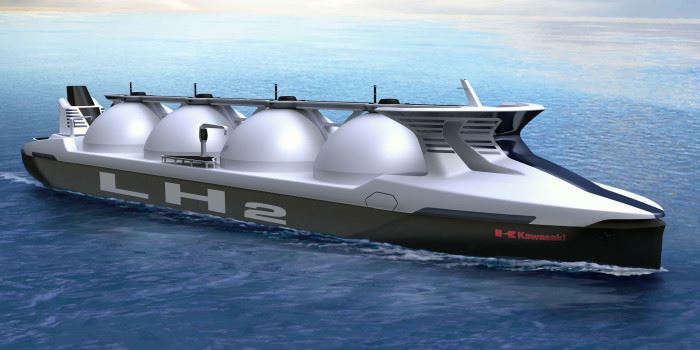Hydrogen is used in industry, and when it is utilised as a fuel it emits only water. Japan’s Kawasaki Heavy Industries (KHI) is currently studying for supplying Japan with CO2-free hydrogen.
Both wind-power and natural gas can be transformed into hydrogen power. On behalf of KHI, and with additional financing by Norway’s state-funded CLIMIT programme, SINTEF has started to survey the possibility of Norway producing the green hydrogen that Japan wants.
SINTEF researchers David Berstad and Petter Nekså have discussed the content of their latest report in an article for the Norwegian business daily “Dagens Næringsliv” dated April 10.
“Japan’s interest in this topic demonstrates that the low-carbon society of the future could offer Norway new prospects for wealth creation and exports,” say the two researchers.
“Many people have claimed that nothing will ever come of the ‘hydrogen economy’, but the Japanese authorities have already started to phase it in. Toyota, the largest car manufacturer in the world, is skipping the electric car stage and moving straight on to hydrogen,” the SINTEF scientists point out in their article.
Here follows the complete article, reprinted with kind permission of the business daily “Dagens Næringsliv”:

David Berstad is a Research Scientist at SINTEF Energy Research
Click to open

Petter Nekså is a Chief Scientist at SINTEF Energy Research
Click to open
Norway exports huge quantities of unrefined natural gas and oil, plus electricity. For its part, Japan is a major net importer of energy, and is preparing to transport much of it to the country in the form of liquid hydrogen.
On their way to a low-carbon economy, the Japanese are looking for exporters who are capable of producing hydrogen without creating CO2 emissions. With Japanese industry as our client, SINTEF has recently completed a preliminary feasibility study of Norway as such a producer.
Hydrogen is used in industry, and when it is utilised as a fuel its only emission is water. Many people have claimed that nothing will ever come of the ‘hydrogen economy’, but the Japanese authorities have started to phase it in. Toyota, the largest car manufacturer in the world, is skipping electric cars and going straight on to hydrogen.
Can be made from both water and natural gas
Hydrogen will never be greener than the way in which it is generated. The simplest way is to start with water and split this into hydrogen and oxygen using electricity (water electrolysis), for example by using ‘green’ electricity from renewable energy sources.
At present, however, it is cheapest to generate hydrogen from gas, oil or coal, but such processes also produce CO2 as a by-product. In order to generate pure hydrogen, the CO2 must be removed. Most fossil-fuelled hydrogen generating plants emit CO2 from this process, but in the USA some of it is extracted from the process, and is used for enhanced oil recovery. CO2 can also be pumped down into geological strata for permanent storage, a solution that makes hydrogen generation from fossil sources virtually emission-free.
Norway has what Japan lacks
Japan’s Kawasaki Heavy Industries (KHI) group is currently studying CO2-free supply lines for hydrogen. One of the projects that the company is evaluating involves hydrogen production from Australian brown coal, with the CO2 being stored on the Australian continental shelf. The hydrogen would be liquefied and transported to Japan in large specialised vessels.
KHI is also studying other alternatives. Theoretically, Japan could produce hydrogen on its own territory from imported natural gas, but it is still not certain whether its geology is suitable for CO2 storage. Nor does the country have an excess of renewable energy for electrolysis. Norway has both a suitable geology and plenty of renewable energy.
Wind power and CCS projects
On behalf of KHI, and with additional financing by Norway’s state-funded CLIMIT programme, SINTEF has started to survey the possibilities at home. KHI envisages annual shipments of around 225,000 tonnes of hydrogen, which would be sufficient to power three million cars. For Norway to generate all of this by electrolysis would require some 14 TWh of energy a year, equivalent to 10 – 12 per cent of the country’s electricity production, and it would need a significant increase in our generating and distribution capacity.
In the green certificate market, Norway is expected to produce 13 TWh of new, renewable energy annually by 2020, according to the aims of the scheme. If all of this were to be sent to hydrogen generation, the Japanese requirements as outlined above could theoretically be met via electrolysis alone. However, the necessary facilities are being developed extremely slowly, and it is not clear how rapidly production capacity will increase.
On the other hand, natural gas is readily available as a source of energy, and Norway could fulfil such an order without using more than roughly 1.5 per cent of the country’s gas production. The feasibility study shows that a resource-optimal solution would probably be to combine electrolysis and production from natural gas, with one third of the total coming from electrolysis, for example. This balance could be altered in the course of time, as gas production tapers off and wind-power generation rises.
Apart from Japan, the European continent is a potential recipient of Norwegian hydrogen. With Norway’s access to renewable energy, natural gas and CO2 storage sites, this country could become a major supplier of green hydrogen. And last but not least; could hydrogen generation be the full-scale project for carbon capture and storage that the politicians are looking for?

